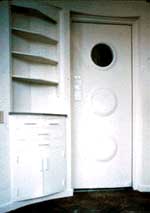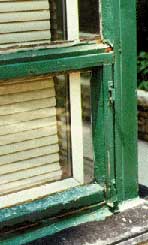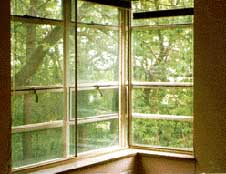
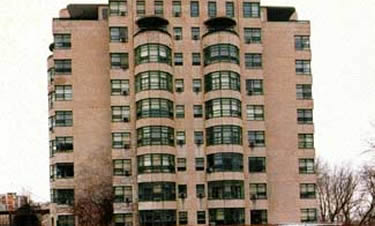


no.3
 If historic windows can't be repaired,
If historic windows can't be repaired,
DO install matching replacements!
::issueFOCUS:: Choosing appropriate replacement windows
::go to REHAB NO'S::
|
[TOP IMAGE] Art Moderne apartment building before work. NPS Photos.
The historic character...
This outstanding Art Moderne style apartment building was constructed
in 1938-39. A freestanding, nine-story, thirty-four unit structure with
a reinforced concrete frame, its exterior wall surfaces are clad in limestone
panels laid over backup tiles. The roof is flat and crowned by an elevator
penthouse. Together with its highly distinctive interior spaces and features,
it is considered among the finest examples of Art Moderne architecture
in the country. Unfortunately, the distinctive windows—steel sash
units—were in an advanced state of deterioration prior to rehabilitation.
...and how it was preserved in the rehabilitation.
It is apparent from the photos (above and right) that the Moderne interior
spaces, features, and finishes have been well maintained over time, and
need only minor work.
|
On the other hand, the exterior was not in as good condition, especially the original steel window units (see exterior and interior photos, left and right). Despite window sash repair and the addition of storm windows to the single pane glass to deter drafting and condensation, excessive heat gain in the summer remained a problem. Two years later, most of the steel sash was rusted, badly bent, or pitted so that window replacement was deemed necessary.
In 1994 the owners began to investigate potential solutions with the goals of maintaining the architectural character of the building, while improving its thermal performance. Three alternatives were considered: (1) restoring the existing steel sash; (2) replacing the windows with new steel sash units; and (3) replacing the windows with new custom frame aluminum windows. The third option was selected because of the severe deterioration of the existing steel sash. Further, no new steel windows could offer an acceptable level of thermal insulation. Custom frame aluminum windows could provide an acceptable match for the configuration, profile, and color of the existing windows.
In replacing the single pane glass steel sash with new custom aluminum frame casement windows, it was critical that there be minimal impact on the exterior character of the historic apartment building. The pattern and dimension of the new windows, as well as the window profiles and exterior finish, would all be duplicated to the greatest extent possible. The original copper window sills were found to be in good condition, permitting their retention.
On the interior, the existing storm sash would be removed, because the new windows had sufficient insulative value by themselves. The original hardware, which still functioned perfectly, would then be immediately accessible. The interior marble sills would be preserved, thus retaining the character of the historic design. Existing, non-historic blinds would also remain.
This proposal and the subsequent rehabilitation work were found to be in conformance with the Secretary of the Interior's Standards for Rehabilitation. Standards 2, 5, and 6 are highlighted on the right.
|
What should you know?
Inappropriate replacement windows can easily detract from the appearance of an entire building and change its historic character. A window survey can be a valuable component of rehabilitation project planning, particularly for buildings of institutional scale. Such a survey establishes the condition, and repair or replacement needs of the existing units.
If it is shown that repair cannot be accomplished due to extensive deterioration, and replacement is thus necessary, any replacement window needs to match the historic sash, the pane size and configuration, the glazing, the muntin detail and profile, and the historic color and trim. Using the same type of material is always the preferred recommendation. If repair is not feasible, then a compatible substitute material can be considered. Special custom work is nearly always required to achieve a satisfactory match.

...and a significant lobby space.
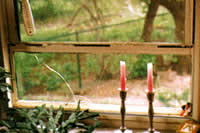
Typical condition of cracked and rusted casement window.
Standard 2: The historic character of a property shall be retained and preserved. The removal of historic materials or alteration of features and spaces that characterize a property shall be avoided.
Standard 5: Standard 5: Distinctive features, finishes, and construction techniques or examples of craftsmanship that characterize a property shall be preserved.
Standard 6: Deteriorated
historic features shall be repaired rather than replaced. Where the severity
of deterioration requires replacement of a distinctive feature, the new
feature shall match the old in design, color, texture, and other visual
qualities and, where possible, materials. Replacement of missing historic
features shall be substantiated by documentary, physical, or pictorial
evidence.
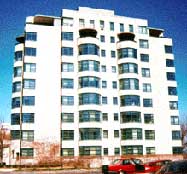
The building's character preserved.
